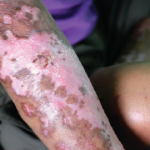BERLIN—Doctors are presented with a 49-year-old woman with pain, weakness, and reduced endurance in the muscles, as well as stiffness in the morning. She is also found to have Raynaud’s phenomenon, symptoms of Sicca syndrome, dysphagia, and shortness of breath.
Lab tests show she is positive for antinuclear antibodies (ANAs), but also anticentromere antibodies, and she is negative for other kinds of myositis antibodies. A nailfold capillaroscopy is negative. Organ screening shows esophageal reflux and a completely normal electrocardiogram, with no signs of ischemia, pericarditis, or ventricular hypertrophy. A computed tomography (CT) scan shows no stenosis.
The woman—whose case was presented here at the European League Against Rheumatism (EULAR) 2012 Annual European Congress of Rheumatology, held June 6–9—might be considered at risk for having systemic sclerosis (SSc). But it is not that simple.
“This woman does not have the major criteria required for the diagnosis,” nor does she meet the 1980 ACR criteria for the classification of SSc, said Ulrich Walker, MD, professor of rheumatology at Felix-Platter and University Hospital in Basel, Switzerland.1 “So this woman, by definition, does not have scleroderma.” [Editor’s note: Because of deficiencies in the old criteria, the ACR and EULAR are supporting a joint project to develop new scleroderma classification criteria.]
She was ultimately diagnosed with undifferentiated connective tissue disease, possibly early SSc. Her case was used to highlight some of the potential pitfalls of handling myopathy in SSc.
A Tricky Diagnosis to Make
Although she does not meet the standard definition, studies have found that 47% of patients with Raynaud’s syndrome, and are ANA positive, end up developing SSc. “This woman is at considerable risk to develop scleroderma over time,” Dr. Walker said.
Dr. Walker warned against relying too much on serum creatinine kinase (CK) levels, because it’s been shown that 20% of patients with biopsy-proven myositis don’t have elevated CK. He suggested that serum CK and serum aldolase, together, can bring about a greater sensitivity. But muscle weakness is much more prevalent than serum CK levels in cases of diffuse SSc, he noted.
He also cautioned that serum CK-MB levels that are elevated aren’t necessarily an indication of myocardial involvement, so myocardial imaging might have to be done, helping to distinguish between impaired microcirculation, enhanced myocardial fibrosis, or inflammation and helping guide the intensity of treatment.
Dr. Walker also mentioned a small study his center performed using blood oxygen level–dependent (BOLD) magnetic resonance imaging, in which images are taken as a cuff inflates around the patient’s thigh and then relaxes. Twelve consecutive patients had more pronounced ischemia and lacked a reactive hyperemia compared to age- and gender-matched controls.

